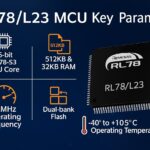Embedded systems, often hidden from plain sight, play a remarkable role in our daily lives, seamlessly integrated into devices and machinery we interact with regularly. These specialized task-specific systems possess a unique set of attributes or characteristics that every embedded system designer should understand before designing an embedded system.
In this blog, we’re spotlighting the 20 characteristics of embedded systems that make embedded systems an indispensable part of our modern world and shaping technological advancements.
Real-Time and Deterministic Operation
Real-time operation is one of the characteristics of an embedded system. Embedded systems operate in real-time by executing tasks and responding to inputs within strict time constraints. They are designed to process information and generate outputs with minimal delay or mostly with strict deadlines.
This real-time capability is crucial in applications where timing is critical, such as in autonomous vehicles, medical devices, and industrial control systems.
Deterministic Behaviour in embedded systems refers to their ability to consistently produce the same results under identical circumstances. This characteristic of an embedded system is essential, especially in scenarios where precise timing and consistent behavior are imperative.
Embedded systems achieve determinism through careful design, where hardware and software components are optimized to guarantee specific responses within predefined timeframes, thereby ensuring a reliable and predictable operation.
Also Read : 12 Types of Embedded Systems
Energy Efficient
Another important characteristic of embedded systems is energy efficiency. Embedded systems are inherently designed for energy efficiency due to their constrained nature, aiming to perform tasks with minimal power consumption.
Energy-efficient design is a top priority for many embedded systems, as they often run on batteries or rely on limited power sources. Techniques like sleep modes, power integrity, and low-power components, PMICs are employed to extend battery life.
Consider the smartphones we use daily. Their operating systems employ embedded systems that manage various functions while conserving energy. These systems regulate processor usage by running some sleep mode algorithms auto-control screen brightness, and manage network connections dynamically to extend battery life.
Low-Cost System
Affordability is a key characteristic of embedded systems. Low-cost embedded systems are designed especially for cost-sensitive Industries such as consumer electronics and IoT sensors.
Mass production, targeted functionality simplified hardware design make the embedded system low-cost.
Reliability
Reliability is also a key characteristic of an embedded system. Embedded systems must operate reliably in various conditions and over extended periods. Failures within these systems can yield significant repercussions, especially in critical domains like medical devices or aerospace applications.
Employing rigorous testing procedures and incorporating redundancy are prevalent approaches employed to uphold and guarantee reliability.
Compact Size and Modular Design
Embedded systems, especially in wearables and IoT devices, need to be really small due to space limitations. They’re designed to fit into tight spots while still working really well.
Such types of embedded systems are built around SoCs, which integrate multiple hardware components (e.g., CPU, GPU, memory, and I/O interfaces) on a single chip. This integration helps reduce size and power consumption.
For example, a smartwatch contains various components like a processor, sensors, memory, and a display, all packed into a tiny space on your wrist. To fit within this compact size, engineers design the embedded system in the smartwatch to be small yet powerful enough to handle tasks like tracking your fitness, receiving notifications, and running various apps, all while conserving energy to maintain battery life.
Another useful characteristic of an embedded system is modular design. Embedded systems are built using modular designs, which means they use parts or components that can be easily swapped out. This makes it simple to upgrade, fix, or maintain these systems without much hassle.
Ease of Connectivity
Yes of course! Ease of connectivity is also considered one of the main characteristics of embedded systems. Networked Embedded systems are often connected within networks, either wired or wirelessly. This network integration allows them to share information, keep an eye on things from a distance, and even control other devices. Think of it like a group chat where everyone shares updates and helps each other out.
To do that kind of communication among the connected systems, seamless connectivity is important in embedded systems.
Application-Specific Hardware and Software
Embedded systems are like specialized systems built with both hardware and software that are perfectly fine-tuned for specific jobs. They use customized hardware components such as ASICs, microcontrollers, or FPGAs, and their software/firmware, often written in languages like C or assembly, is super precise and talks directly to the hardware.
This special design makes them work really well for their specific tasks, using resources efficiently and making sure they’re reliable for what they’re meant to do.
Memory Management
Memory management in embedded systems involves handling and optimizing the use of memory resources to ensure efficient operation. It’s crucial in these systems because they often have limited memory capacities.
Embedded systems employ various memory management techniques to make the most of their available memory:
- Resource Optimization
- Memory Partitioning
- Memory Protection
- Dynamic Memory Allocation
- Reduced Memory Footprint
Environmental Adaptability
Embedded systems intended for harsh environments, like those in industrial machinery or outdoor sensors, need to withstand tough conditions such as extreme temperatures, moisture, or vibrations. For instance, a sensor used in a factory might face high temperatures or vibrations from heavy machinery, while a weather monitoring device outdoors might endure temperature fluctuations and humidity.
To handle these challenges, Embedded system engineers design these systems with rugged components and protective casings. They use materials resistant to extreme temperatures or moisture and employ techniques like conformal coating to shield sensitive parts from environmental stress. Additionally, they might implement shock-absorbing mounts to mitigate the impact of vibrations.
Built-in Safety Measures
Safety is super important in applications like. Embedded systems incorporate safety features to mitigate risks, such as error detection and correction, redundant systems, and fail-safe mechanisms.
Security in embedded systems is vital as they’re present in various devices like medical devices, automotive control, smart home appliances, and various critical infrastructures. Embedded systems implement safety measures such as Unauthorized Access Prevention, Data Breach Protection, Tamper Resistance, Encryption, Authentication Protocols
Long Lifecycle
Embedded systems are built to stick around much longer than your typical computer. They’re meant to keep working reliably for a really long time, sometimes even for decades, without getting old.
consider a car’s engine control unit (ECU) as an example of an embedded system with a long lifecycle. The ECU manages the engine’s operation, controlling fuel injection, ignition timing, and various other crucial functions.
Car manufacturers design the ECU to last for the entire lifespan of the vehicle, which can be over a decade. Despite advancements in technology, the ECU remains functional and relevant throughout the car’s lifetime without needing frequent upgrades or replacements. It continues to effectively manage the engine’s performance, showcasing the durability and longevity typical of embedded systems.
Flexible System Integration
Embedded systems frequently have to work together with other subsystems, smaller systems, or even whole systems. Making sure they fit well and work smoothly with these other components or subsystems is really important for them to do their job properly.
Imagine a smart home system where various devices like thermostats, lights, and security cameras are interconnected. An embedded system within this setup might be a central controller unit designed to integrate seamlessly with these different devices.
his controller unit is built with flexible system integration in mind. It’s programmed to communicate with and manage the various devices regardless of their brands or specific functionalities. For instance, it can work with different thermostat models, light brands, and security camera types without any issues. This flexibility enables the system to function as a cohesive unit, allowing users to control multiple devices through a single interface or platform.
Multicore and Parallel Processing
In modern embedded systems used for demanding tasks, they’re starting to use multicore processors and parallel processing more often. This helps them handle multiple tasks at once.
For situations where lots of things need to happen simultaneously, embedded systems use tricks like multithreading and concurrency. These techniques make them work more efficiently and respond faster to different demands.
Scalability
Scalability in embedded systems refers to their ability to adapt and accommodate changes in processing demands, storage requirements, or device complexity.
Imagine an embedded system in a smart home hub. Initially, it manages basic functions like controlling lights and thermostats. However, as more devices are added to the network—such as security cameras, smart appliances, or environmental sensors—the system’s workload increases.
A scalable embedded system can handle this growth without significant performance issues. It can be adjusted or expanded to manage the increased processing demands, additional data storage, or the complexities introduced by the new devices. This adaptability ensures that the system remains efficient and effective even as the demands placed upon it grow.
So, scalability in embedded systems means they can grow or adapt as needed, accommodating changes in workload or device complexity without sacrificing performance or functionality.
Interoperability
Interoperability in embedded systems refers to their ability to effectively communicate and work with various devices or systems using different communication protocols.
Embedded systems often have to connect with other devices or systems, which means they need to be able to work with different communication protocols like UART, SPI, I2C, Ethernet, or wireless tech such as Wi-Fi, Bluetooth, or Zigbee.
Life-Cycle Management
Lifecycle management in embedded systems refers to the process of handling the system’s entire lifespan, from design and development to deployment, maintenance, and eventual retirement.
Lifecycle management ensures that embedded systems are maintained, updated, and retired in a systematic and efficient manner. This comprehensive approach aims to maximize the system’s reliability, security, and longevity throughout its operational lifespan.
Adaptability to Changing Requirements
The adaptability of embedded systems ensures they can be modified or enhanced to meet new requirements or incorporate additional features without needing a complete overhaul, thereby extending their usefulness and relevance over time.
Consider an embedded system within a smart thermostat. Initially, its main function might be to control the temperature based on user settings. However, as technology advances, new features such as integration with voice assistants or compatibility with smart home ecosystems become desired.
An adaptable embedded system can accommodate these changes. It can be updated or expanded through software upgrades to integrate new functionalities or communicate with different devices or platforms. This adaptability allows the system to evolve and stay relevant amid changing user preferences or technological advancements.
Predictive Maintenance and Field Serviceability
Predictive maintenance and field serviceability are essential characteristics in embedded systems, especially in applications like industrial machinery or IoT devices.
Embedded systems equipped with predictive maintenance capabilities utilize sensors and data analysis to predict potential issues or failures before they occur.
For instance, in manufacturing equipment, sensors can monitor parameters like temperature, vibration, or fluid levels. By analyzing this data, the system can predict when components might fail or need maintenance.
This proactive approach helps prevent unexpected breakdowns, reducing downtime and minimizing repair costs.
Field Serviceability characteristic refers to the system’s ease of maintenance or repair in the field, without requiring extensive expertise or specialized tools.
For instance, an embedded system in a remote monitoring device might have modular components that can be easily replaced or upgraded by on-site technicians. This field serviceability reduces downtime and maintenance costs, allowing quick resolutions to issues without the need for returning the entire system to a service center.
Rapid Boot and Initialization
Rapid boot and initialization in embedded systems refer to their ability to start up quickly and become fully operational within a short timeframe after powering on. This characteristic holds several advantages such as improved user experience, energy efficiency, and enhanced reliability.
Legacy Compatibility
Legacy compatibility in embedded systems refers to their ability to work seamlessly with older technologies, systems, or software even as newer versions or advancements emerge.
Legacy compatibility enables different generations of technology to communicate and work together, ensuring that newer embedded systems can still interact with older devices or software seamlessly.
legacy compatibility in embedded systems preserves operational continuity, protects investments in existing infrastructure, and facilitates smoother transitions between older and newer technologies, ensuring more efficient and cost-effective utilization of resources over time.
Conclusion
Embedded systems form the unseen backbone of our daily technology, offering a range of vital characteristics. From their real-time precision to energy efficiency and compact designs, these systems power crucial functions across industries. Their reliability, adaptability, and seamless connectivity underscore their importance in our interconnected world.
Author Profile
- 20+ years embedded hardware design professional with a burning passion for teaching. Sharing the intricate world of embedded hardware is my mission and joy.
Latest entries
 Tech Updates30 November 2025STM32WBA6: The Next-Generation MCU Powering Secure Short-Range Wireless Designs
Tech Updates30 November 2025STM32WBA6: The Next-Generation MCU Powering Secure Short-Range Wireless Designs Blogs24 November 2025High-Speed PCB Layout Design Guide-104
Blogs24 November 2025High-Speed PCB Layout Design Guide-104 Tech Updates14 September 2025Renesas Launches RL78/L23 Ultra-Low-Power MCUs to Power Smarter Home Appliances
Tech Updates14 September 2025Renesas Launches RL78/L23 Ultra-Low-Power MCUs to Power Smarter Home Appliances Blogs7 September 2025High-Speed PCB Layout Design Guide-103
Blogs7 September 2025High-Speed PCB Layout Design Guide-103











